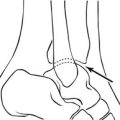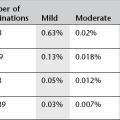Breast
Mammography
Indications
1. Focal signs in women aged >40 years in the context of triple (i.e. clinical, radiological and pathological) assessment at a specialist, multidisciplinary diagnostic breast clinic
2. Following diagnosis of breast cancer, to exclude multifocal/multicentric/bilateral disease
3. Breast cancer follow-up, no more frequently than annually or less frequently than biennially for at least 10 years
4. Population screening of asymptomatic women with screening interval of 3 years, in accordance with NHS Breast Screening Programme policy:
(a) By invitation, women aged 47–73 years in England, Northern Ireland and Wales and 50–70 years elsewhere in UK
(b) Women >73 years, by self-referral (there is no upper age limit)
5. Screening of women with a moderate/high risk of familial breast cancer who have undergone genetic risk assessment in accordance with National Institute for Health and Clinical Excellence (NICE) guidance
6. Screening of a cohort of women who underwent the historical practice of mantle radiotherapy for treatment of Hodgkin’s disease when aged <30 years. These women have a breast cancer risk status comparable to the high-risk familial history group1
7. Investigation of metastatic malignancy of unknown origin.
Not indicated
1. Asymptomatic women without familial history of breast cancer, aged <40 years
2. Investigation of generalized signs/symptoms, e.g. cyclical mastalgia or non-focal pain/lumpiness
3. Prior to commencement of hormone replacement therapy
4. To assess the integrity of silicone implants
5. Individuals affected by ataxia-telangiectasia mutated (ATM) gene mutation with resultant high sensitivity to radiation exposure, including medical X-rays
Equipment
Ongoing developments of FFDM include:
1. Tomosynthesis which creates a single three-dimensional image of the breast by combining data from a series of two-dimensional radiographs acquired during a single sweep of the X-ray tube. Ongoing studies suggest that this technique may improve diagnostic accuracy in screening of the order of 30%, reduce recall by an estimated 40% and has a radiation dose of approximately 50% of that of a single mammographic exposure
2. Contrast-enhanced digital mammography, i.e. angiomammography. Two approaches are being developed: temporal sequencing (in which images pre and post contrast are subtracted with a resultant angiomammogram) and dual energy imaging (in which imaging at low and high energies detailing, respectively, parenchyma and fat with and without iodine are obtained. The subsequent views can then be subtracted
3. Computer-aided detection (CAD) software can assist film reading by placing prompts over areas of potential mammographic concern. There is evidence that, even in the screening setting, single reading in association with CAD may offer sensitivities and specificities comparable to that of double reading.4
If conventional film-screen mammographic imaging is to be carried out, it should be performed on a dedicated unit which includes in its specification:
1. Dual-focus X-ray tube: 0.1/0.3 focal spot size
2. Dual filtration: molybdenum/rhodium
3. Choice of rotating target material: molybdenum/rhodium/tungsten
4. 18 × 24 cm and 24 × 30 cm interchangeable buckys
5. Automatic/semi-automatic and manual exposure control
6. Carbon fibre table top assembly with reciprocating or oscillating grid, average grid ratio 5 : 1
Technique
Additional views may be required to provide adequate visualization of specific anatomical sites:
Compression of the breast is an integral part of mammographic imaging resulting in:
1. Reduction in radiation dose
2. Immobilization of the breast, thus reducing blurring
3. Uniformity of breast thickness allowing even penetration
4. Reduction in breast thickness thus reducing scatter/noise achieving higher resolution.
Adaptation of the technique can provide additional information:
References
1. Hancock, SL, Tucker, MA, Hoppe, RT. Breast cancer after treatment of Hodgkin’s disease. J Natl Cancer Inst. 1993; 85:25–31.
2. Eklund, GW, Busby, RC, Miller, SH, et al. Improved imaging of the augmented breast. Am J Roentgenol. 1988; 151:469–473.
3. Pisano, ED, Gatsonis, C, Hendrick, E, et al. Diagnostic performance of digital versus film mammography for breast cancer screening. N Engl J Med. 2005; 353:1773–1783.
4. Gilbert, FJ, Astley, SM, McGee, MA, et al. Single reading with computer-aided detection and double reading of screening mammograms in the United Kingdom National Breast Screening Program. Radiology. 2006; 241:47–53.
Health Technology Assessment. The clinical effectiveness and cost-effectiveness of different surveillance mammography regimes after the treatment for primary breast cancer: systematic reviews registry database analyses and economic evaluation. Health Technology Assessment. 2011; 15(34):1–322.
NICE Clinical Guidelines. The Classification and Care of Women at Risk of Familial Breast Cancer in Primary, Secondary and Tertiary Care. http://www. nice. org. uk/nicemedia/live/10994/30244/30244. pdf, 2006.
Tucker, AK, Ng, YY. Textbook of Mammography. In: Tucker AK, Ng YY, eds. Textbook of Mammography. 2nd ed. Edinburgh: Churchill Livingstone; 2001:18–64.
Willet, AM, Michell, MJ, Lee, MJR. Association of Breast Surgery: Best Practice Diagnostic Guidelines for Patients Presenting with Breast Symptoms. www. associationofbreastsurgery. org. uk, 2010.
Ultrasound
Indications
1. Focal signs in women aged <35 years in the context of triple (i.e. clinical, radiological and pathological) assessment at a specialist, multidisciplinary diagnostic breast clinic
2. As an adjunctive method to improve diagnostic sensitivity and specificity in women aged >35 years with a mammographic and/or clinical abnormality
3. Following diagnosis of breast cancer to assess initial tumour size or response to neo-adjuvant therapy
4. Assessment of implant integrity
5. Diagnosis, drainage guidance and follow-up of breast abscess
6. Targeting diagnostic biopsy/pre-operative localization of both palpable and impalpable breast lesions
7. To guide axillary lymph node biopsy, thus informing choice of surgical management.1
Additional technique
Elastography is a non-invasive US technique, which provides a visual representation of the stiffness (elasticity) of both normal and abnormal tissue.2 US imaging is used to examine tissue, both before and after minimal compression. A colour-coded image is generated with dark tissue representing least compressible tissue, i.e. with a higher index of suspicion of malignancy.
References
1. Damera, A, Evans, AJ, Cornford, EJ, et al. Diagnosis of axillary nodal metastases by ultrasound guided core biopsy in primary operable breast cancer. Br J Cancer. 2003; 89:1310–1313.
2. Zhi, H, Ou, B, Luo, B-M, et al. Comparison of ultrasound elastography, mammography and sonography in the diagnosis of solid breast lesions. J Ultrasound Med. 2007; 26:807–815.
Magnetic resonance imaging
Indications
1. Detection/exclusion of recurrent malignant disease in the conserved breast ≥6 months following surgery. Mature scar tissue, which may mimic malignancy morphologically, does not enhance with resultant high negative predictive value
2. Assessment of implant integrity
3. Monitoring response to neo-adjuvant therapy
4. Combined with mammography, as a screening tool1 in women deemed to be at high risk of developing breast cancer (see above, mammography section)
5. In carefully selected cases, to clarify equivocal or suspicious mammographic and US findings
6. Investigation of occult breast cancer. 0.3% of patients present with malignant axillary lymphadenopathy but normal breast triple assessment.
Indications under evaluation
1. Detection of unsuspected multifocal/multicentric/contralateral disease. This may be of particular value in the pre-operative staging of invasive lobular disease. A high proportion of lesions identified on MRI can be located on second look US and are, therefore, amenable to conventional biopsy. All biopsy techniques can be adapted for use with MRI guidance
2. MRI may have a role in the pre-operative evaluation of the extent of high grade (Grade 3) ductal carcinoma in situ (DCIS).
Technique
1. Contraindications as for standard MRI examinations
2. Lying prone, with breasts placed in a dedicated surface coil, images are obtained pre and post contrast (0.1–0.2 mmol kg−1 gadolinium chelate contrast, given i.v. via pump injector) in either axial fat suppression or coronal subtraction sequences. The presence, amount, speed and morphology of the pattern of enhancement are analysed
Radionuclide imaging
Image-guided breast biopsy
Indications
Equipment
(a) US guidance; using hand-held, high-frequency (8–18-MHz) probe. The avoidance of radiation combined with accessibility of the technique results in this approach being used wherever possible
(b) X-ray guidance; applying the principle of stereotaxis whereby imaging a static object from two known angles from a known zero point can provide data from which the x, y and z co-ordinates can be calculated. Small-field digital stereotactic equipment can be purchased as an add-on to conventional mammography machines, thus providing the most common approach to X-ray-guided biopsy, namely with the patient in the seated, upright position. Less commonly, the small-field digital stereotactic system is attached to a prone table (dedicated to biopsy use) with resultant increased accessibility for posteriorly sited lesions and reduction in syncopal episodes; advantages which can be reproduced by the use of an appropriate biopsy chair allowing the adoption of the lateral decubitus position in conjunction with an upright imaging system
2. Automated biopsy gun. Choice of needle depends on the nature of the mammographic abnormality. For US-guided biopsy of masses, 14G biopsy needle is adequate. For biopsy of clustered microcalcifications and parenchymal distortions, large-volume needles (up to 7G) in conjunction with vacuum-assisted techniques increase diagnostic accuracy.
Patient preparation
Technique
1. Standard skin cleansing and local anaesthetic infiltration
2. Biopsy needle introduced via automated biopsy gun
3. At the time of biopsy, when the mammographic target may be completely removed by diagnostic biopsy or to confirm concordance of the target site with other imaging modalities, a titanium marker can be deployed either via an introducer or the large-volume biopsy needle. Some tissue markers comprise not only a radio-opaque clip but a series of collagen pellets rendering the marker ultrasonically visible for up to 6 weeks
Pre-operative localization
Equipment
2. Non-allergenic adhesive to fix the wire to adjacent skin
3. Swabs – coloured to be easily identifiable as separate from those used in theatre
(a) The avoidance of radiation and accessibility of the technique results in US being the method of image guidance of choice, particularly if the original pre-operative biopsy was achieved via US guidance. Lesions which on US are visible <4 cm from skin can be amenable to the technique of skin marking, avoiding the requirement of a localizing wire. Following discussion with the surgeon, the operative position of the patient should be reproduced. With the US probe immediately overlying the lesion, the skin is marked and the depth to target is measured. At operation, the site of the skin mark is incised and dissection through the relevant distance is undertaken
(b) X-ray guidance using fenestrated grid or stereotactic devices can be used for the placement of the localizing wire.
Technique
1. Standard skin cleansing and local anaesthetic infiltration
2. In cases of extensive (i.e. >2 cm) microcalcification, the placement of multiple wires may aid adequacy of excision
3. After wire placement, mammograms (orthogonal views) indicating the precise position of the tip of the localizing wire are taken. These must be available to the surgeon at the time of operation
4. Using magnification technique (see Mammography section), X-ray of the surgical specimen is undertaken to confirm excision of the mammographic lesion both at the time of operation (allowing further sampling) and at the postoperative MDT.
Liberman, L. Percutaneous image-guided core breast biopsy. Radiol Clin North Am. 2002; 40:483–500.
NHSBSP Publication No 20. Quality Assurance Guidelines for Surgeons in Breast Cancer Screening 3rd edn NHSBSP: Sheffield. http://www. cancerscreening. nhs. uk/breastscreen/publications/nhsbsp20-3rd. pdf, 2003.





